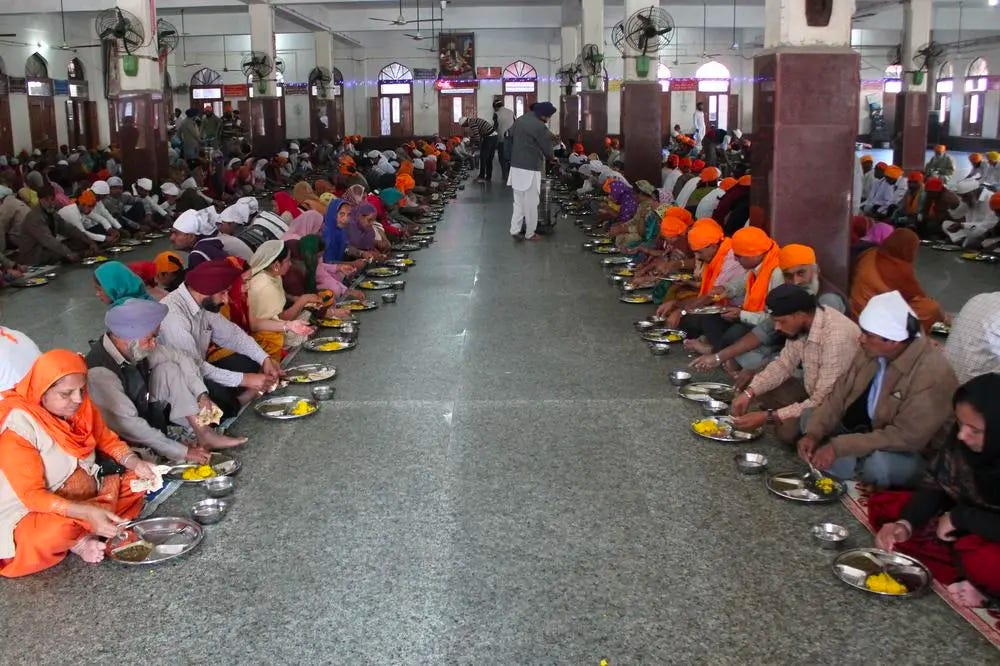Hi friends, sorry for the looong delay, but here to share another episode in the Book of the Month series. I recently read the book, “Seva: Sikh Secrets on How to be Good in the Real World” by Jasreen Mayal Khanna.
The book explores the central aspect of “seva” (translates to selfless service) in Sikhism which is the world’s fifth largest religion. There have been countless stories of Sikh seva, particularly during the pandemic in both India and elsewhere, from providing hospital beds and oxygen cylinders to figuring out unique ways to serve food during social distancing. The author, a Sikh herself, looks back at her upbringing to discuss what makes Sikhs so generous. She distills Sikhi, the path of Sikhism, into eight simple and every day behaviors that anyone from any religion can try to inculcate in their lives if they deem appropriate. For each of the behavior which turns into a chapter, she first explores the origins of that behavior in Sikhs, which generally tie back to the lives and lessons of the ten gurus. She also provides examples from her own life as well as other Sikhs around her following that behavior. She then provides evidence from modern day studies which suggest the positive impact of that behavior in our lives and then ends the chapter with some practical suggestions to include that behavior in our lives.
The eight behaviors that the book focuses on are:
- Help Someone Every Day
- Embrace Joy
- Be Brave
- Say Thank You Daily
- Learn to Laugh at Yourself
- Practise Equality at Home
- Work Harder Than You Pray
- Live in Chardi Kala
Ultimately, she says that all of these, be it laughter, courage, or even embracing joy, they are either a form of seva or enable Sikhs to practice seva.
Growing up personally, my family would take me to the local gurudwara (Sikh temple) on my birthday to seek blessings even though I come from a Hindu family. I always enjoyed the peaceful vibe there. Plus whenever that gurudwara hosted annual langar, which is the practice of preparing and serving free food to everyone, I and my friends would visit with lots of enthusiasm, even in 45 degrees celsius heat. Not to mention the boxes and bags we would carry to bring some langar back with us. I was already impressed at the scale at which the langar happened and the number of people who would have food in my local gurudwara but when I visited the Golden Temple in Amritsar, the holiest Sikh shrine, I was amazed at the magnitude of operations. Anyone can walk in at any point of time, day or night, and they will be fed with tasty food. The gurudwara feeds more than 100,000 people every day. Plus the systematic way in which everything happens is quite a sight too. It’s all peaceful and smooth, with everyone doing their bit of seva.

In the book, Jasreen highlights a BBC interview with Michelin star chef Vikas Khanna in 2020, in which he was asked by the anchor whether his sense and understanding of hunger came from India as he didn’t grow up in a rich family. To this Khanna replied: ‘I understand, but my sense of hunger didn’t come from India so much because I was born and raised in Amritsar. We have a huge community kitchen, where everyone gets fed. The entire city can feed there. My sense of hunger actually came from New York when I was struggling here from the very bottom.’
Another thing implicit in langar is equality. No matter which religion, caste, or economic background one belongs to, everyone sits together on the floor and eats the same food. While it’s common in many homes to have separate plates and spoons just to be used by domestic helpers, in a gurudwara, everyone is treated equally and you are just given one of the plates.

Another example of how equality is built in Sikhism is that Sikh first names are gender neutral. From the first name, you generally can’t tell whether the person is male or female. You need to know whether the following name is Singh (for males) or Kaur (for females) to distinguish. It’s totally possible to get a wedding invitation where both bride and groom are named Parminder.
Jasreen also talks about the humor in Sikhs. She writes, “It’s obviously a generalization to say every Sikh is funny, but I believe that there is a grain of truth to this stereotype. Sikhs aren’t just humorous, they also laugh at jokes made at their expense. In fact, I’d go so far as to say they know the most sardarji jokes of all and laugh the hardest at them.” I will also have to agree that the Sikhs I have known have been some of the funniest people I know. She describes how humor gives the strength to look at the lighter side of life, and allows one to be happy and carefree despite it. “Sikhs can spend hours discussing something or someone they don’t approve of, and they shrug off all the negativity with a simple, ‘Saanu Ki’, which loosely translates to ‘How does it matter to us’, or ‘Who cares’”.

The final chapter of the book is about living in “Chardi Kala”. It’s a phrase that I have heard often in Punjabi movies as well as in gurudwaras. I knew it meant something positive but wasn’t sure exactly what. The author writes: “Chardi kala literally means eternal positivity, but people also interpret it as a buoyant attitude to life, being in high spirits or channelling optimism in both happy and troubled times”. She explains how Chardi Kala means to break the habit of complaining and to try for a silver lining. It’s the spirit of Chardi Kala which guides and enables the Sikhs to contribute to seva. The giving comes from a feeling of abundance which they are able to cultivate by looking beyond their own challenges and focusing on “sarbat da bhala” (prosperity for everyone).
Jasreen rightly points out that it’s very likely that one would meet Sikhs who don’t possess many or even all of the behaviors she outlines in the book. She makes generalizations in the book to understand the community’s values. As she writes, “the point is to study the Sikh way of life and find some value in the wonderful lessons it offers. Whatever you choose to learn or not learn from this book, if I can make you hope and believe that we can help and rely on each other, that we can face adversity and still laugh, that we can live large and also be selfless, I will consider this book a worthy effort.”